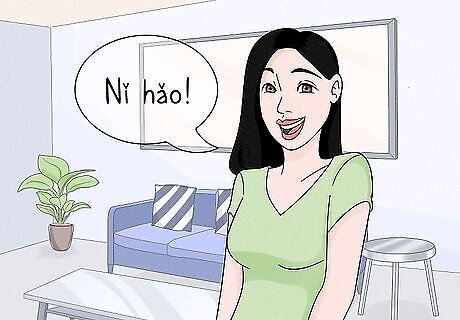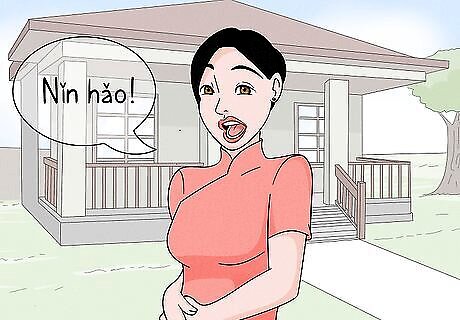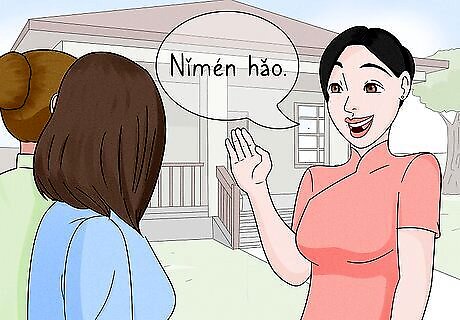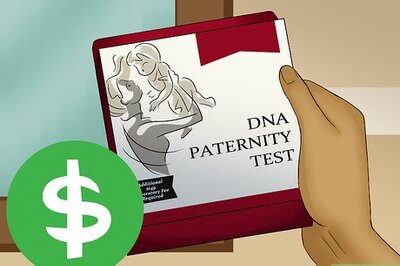
views
Mandarin Chinese

Tell one person "nǐ hǎo." The standard way of greeting someone is in Chinese with this informal Mandarin "hello." Remember to know how to pronounce the Chinese tones first before attempting. Translated directly, the phrase means something along the lines of "you good?" In Chinese script, this greeting is written as 你好. This greeting is roughly pronounced as knee how" "Ni" in this case is pronounced as a second/rising tone because it is located before another third tone word. "He" is a third tone word (the pitch of your voice should dip slightly and then rise to a higher pitch).

Be more formal with "nín hǎo." This greeting shares the same meaning as "nǐ hǎo," but it is a little more polite than its counterpart. Even though this phrase is more formal, it is not as common as "nǐ hǎo." "Nin" is the polite form of "you", but this formality can indicate a distance between you and the speaker. In Chinese script, this greeting is written as 您好. A rough pronunciation of nín hǎo is Neen how". "Nina" is a second (rising) tone.

Greet a group with "nǐmén hǎo." You should switch to this greeting when saying hello to more than one person. The term "nǐmén" is a plural form of "nǐ," meaning "you." In Chinese script, write nǐmén hǎo as 你们好. A rough pronunciation would be knee-men how". "Ni" is a third tone here, which should be connected with the particle men (second tone) after it.

Answer the phone with "wéi." When answering or calling someone on the telephone, say "hello" as "wéi." Note that wéi is not usually used as a greeting in person. It is generally restricted to telephone conversations. In Chinese script, wéi is written as 喂. A rough pronunciation of wéi is a way. This can be pronounced in a second tone as a question or a fourth (falling) tone to get someone's attention.
Cantonese Chinese

Say "néih hóu." This phrase is almost identical in meaning and pronunciation to the Mandarin version of "hello." Even in native Chinese script, the Mandarin and Cantonese versions of "hello" are both written as 你好. The romanization of these two greetings is different, however, and there are slight variations in pronunciation between the two. The Cantonese néih hóu is somewhat softer than the Mandarin nǐ hǎo. Instead of pronouncing the greeting as nee how, pronounce it more like nay ho.

Answer the phone with "wái." As with néih hóu, this telephone greeting is almost identical to its Mandarin counterpart in terms of meaning and pronunciation. As in Mandarin, the native Chinese script is written as 喂. The way to pronounce wái is slightly different in Cantonese. Pronounce it more like why instead of whey. It sounds kind of like way, but puts more emphasis on the "ay" and lower your voice a bit.
Other Dialects

Stick with versions of "nǐ hǎo" to be safe. While exact pronunciation varies from region to region and dialect to dialect, the most common way to say "hello" is almost always some form of "nǐ hǎo." In all dialects, the Chinese script for this greeting is written as 你好. Note that the romanization of 你好 will usually give you a rough idea of how to pronounce it. In Hakka Chinese, for instance, the romanization is Ni ho. The beginning nǐ sound is harder, while the ending hǎo sound sounds less like the English "ow" and more like the English long "o." In Shanghainese, on the other hand, the romanization is "Nong Hao." While the hǎo portion is very similar, the beginning nóng sound is more elongated and comes to a hard conclusion at the end of the syllable.

Answer the phone with "oi" in Hakka Chinese. The Mandarin and Cantonese phone greetings do not work with Hakka Chinese. Used in other contexts, oil is an interjection meaning something along the lines of "oh." In Chinese script, I am writing as 噯. A rough pronunciation is simply Oy or ay.

Greet a crowd with "dâga-haó" in Shanghainese. This greeting translates into "hello everybody" and can be used when greeting more than one person. In native Chinese script, this phrase is written as 大家好. A rough pronunciation of this phrase is due-gee how". DA is a fourth (sharp, falling) tone and Jia is a sustained pitch (a first tone word).




















Comments
0 comment